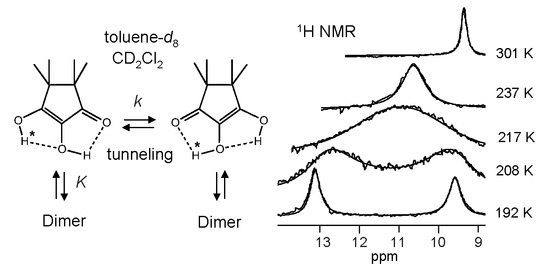Double Proton Tautomerism via Intra- or Intermolecular Pathways? The Case of Tetramethyl Reductic Acid Studied by Dynamic NMR: Hydrogen Bond Association, Solvent and Kinetic H/D Isotope Effects
Abstract
1. Introduction
2. Materials and Methods
2.1. Synthesis of TMRA
2.2. Sample Preparation
2.3. 1H NMR Measurements
2.4. Analysis of the NMR Data
3. Results
3.1. 1H NMR Spectroscopy
3.2. NMR Chemical Shift Data Analysis
3.3. Arrhenius Diagrams of the Tautomerism of TMRA
4. Discussion
4.1. General Remarks
4.2. Solvent-Dependent NMR Spectroscopy and Monomer-Dimer Equilibrium of TMRA
4.3. OH Chemical Shift Assignments and Hydrogen Bond Geometries
4.4. Arrhenius Diagrams of the TMRA Tautomerism
4.5. Mechanism of the TMRA Tautomerism
5. Conclusions
Author Contributions
Funding
Institutional Review Board Statement
Informed Consent Statement
Data Availability Statement
Acknowledgments
Conflicts of Interest
Sample Availability
References
- Antonov, L. (Ed.) Tautomerism: Methods and Theories; Wiley-VCH: Weinheim, Germany, 2014. [Google Scholar]
- Antonov, L. (Ed.) Tautomerism: Concepts and Applications in Science and Technology; Wiley-VCH: Weinheim, Germany, 2016. [Google Scholar]
- Limbach, H.H.; Lopez, J.M.; Kohen, A. Arrhenius Curves of Hydrogen Transfers: Tunnel Effects, Isotope Effects and Effects of Pre-Equilibria. Phil. Trans. B 2006, 361, 1399–1415. [Google Scholar] [CrossRef]
- Limbach, H.H.; Denisov, G.S.; Shenderovich, I.G.; Tolstoy, P.M. Proton Tautomerism in Systems of Increasing Complexity: Examples from Organic Molecules to Enzymes. In Tautomerism: Concepts and Applications in Science and Technology; Wiley-VCH: Weinheim, Germany, 2016; Chapter 14; pp. 329–372. [Google Scholar]
- Limbach, H.H. Single and Multiple Hydrogen/Deuterium Transfer Reactions in Liquids and Solids. In Hydrogen Transfer Reactions; Hynes, J.T., Klinman, J., Limbach, H.H., Schowen, R.L., Eds.; Wiley-VCH: Weinheim, Germany, 2007; Chapter 6; pp. 135–221. [Google Scholar]
- Limbach, H.H.; Schowen, B.K.; Schowen, R.L. Heavy Atom Motions and Tunneling in Hydrogen Transfer Reactions: The Importance of the Pre-tunneling State. J. Phys. Org. Chem. 2010, 23, 586–605. [Google Scholar] [CrossRef]
- Limbach, H.H.; Denisov, G.S.; Golubev, N.S. Hydrogen Bond Isotope Effects Studied by NMR. In Isotope Effects in Chemistry and Biology; Kohen, A., Limbach, H.H., Eds.; Taylor & Francis: Boca Raton, FL, USA, 2005; Chapter 7; pp. 193–230. [Google Scholar]
- Limbach, H.H.; Tolstoy, P.M.; Pérez-Hernández, N.; Guo, J.; Shenderovich, I.G.; Denisov, G.S. OHO Hydrogen Bond Geometries and NMR Chemical Shifts: From Equilibrium Structures to Geometric H/D Isotope Effects with Applications for Water, Protonated Water and Compressed Ice. Israel J. Chem. 2009, 49, 199–216. [Google Scholar] [CrossRef]
- Koeppe, B.; Guo, J.; Tolstoy, P.M.; Denisov, G.S.; Limbach, H.H. Solvent and H/D Isotope Effects on the Proton Transfer Pathways in Heteroconjugated Hydrogen-Bonded Phenol-Carboxylic Acid Anions Observed by Combined UV-Vis and NMR Spectroscopy. J. Am. Chem. Soc. 2013, 135, 7553–7566. [Google Scholar] [CrossRef] [PubMed]
- Koeppe, B.; Tolstoy, P.M.; Limbach, H.H. Reaction Pathways of Proton Transfer in Hydrogen-Bonded Phenol-Carboxylate Complexes Explored by Combined UV-Vis and NMR Spectroscopy. J. Am. Chem. Soc. 2011, 133, 7897–7908. [Google Scholar] [CrossRef]
- Koeppe, B.; Tolstoy, P.M.; Guo, J.; Denisov, G.S.; Limbach, H.H. Combined NMR and UV−Vis Spectroscopic Studies of Models for the Hydrogen Bond System in the Active Site of Photoactive Yellow Protein: H−Bond Cooperativity and Medium Effects. J. Phys. Chem. B 2021, 125, 5874–5884. [Google Scholar] [CrossRef]
- Smirnov, S.N.; Golubev, N.S.; Denisov, G.S.; Benedict, H.; Schah-Mohammedi, P.; Limbach, H.H. Hydrogen/Deuterium Isotope Effects on the NMR Chemical Shifts and Geometries of Intermolecular Low-Barrier Hydrogen Bonded Complexes. J. Am. Chem. Soc. 1996, 118, 4094–4101. [Google Scholar] [CrossRef]
- Braun, J.; Schwesinger, R.; Williams, P.G.; Morimoto, H.; Wemmer, D.E.; Limbach, H.H. Kinetic H/D/T Isotope and Solid State Effects on the Tautomerism of the Conjugated Porphyrin Monoanion. J. Am. Chem. Soc. 1996, 118, 11101–11110. [Google Scholar] [CrossRef]
- Lopez del Amo, J.M.; Langer, U.; Torres, V.; Buntkowsky, G.; Vieth, H.M.; Pérez-Torralba, M.; Sanz, D.; Claramunt, R.M.; Elguero, J.; Limbach, H.H. NMR Studies of Ultrafast Intramolecular Proton Tautomerism in Crystalline and Amorphous N,N’-Diphenyl-6-aminofulvene-1-aldimine: Solid State, Kinetic Isotope and Tunnel Effects. J. Am. Chem. Soc. 2008, 130, 8620–8632. [Google Scholar] [CrossRef]
- Scherer, G.; Limbach, H.H. Proton and Heavy Atom Motions during the Stepwise Proton Tautomerism of Various Oxalamidines. A Semiempirical PM3-MNDO Study. Croat. Chem. Acta 1994, 67, 431–440. [Google Scholar]
- Scherer, G.; Limbach, H.H. Dynamic NMR Study of the Tautomerism of Bicyclic Oxalamidines: Kinetic HH/HD/DD Isotope and Solvent Effects. J. Am. Chem. Soc. 1994, 116, 1230–1239. [Google Scholar] [CrossRef]
- Stöckli, A.; Meier, B.H.; Meyer, R.; Ernst, R.R. Hydrogen Bond Dynamics in Isotopically Substituted Benzoic Acid Dimers. J. Chem. Phys. 1990, 93, 1502–1520. [Google Scholar] [CrossRef]
- Xue, Q.A.; Horsewill, A.J.; Johnson, M.R.; Trommsdorff, H.P. Isotope Effects Associated with Tunneling and Double Proton Transfer in the Hydrogen Bonds of Benzoic Acid. J. Chem. Phys. 2004, 120, 11107–11119. [Google Scholar] [CrossRef] [PubMed]
- Gerritzen, G.; Limbach, H.H. Kinetic Isotope Effects and Tunneling in Cyclic Double and Triple Proton Transfer between Acetic Acid and Methanol in Tetrahydrofuran Studied by Dynamic Proton and Deuteron NMR Spectroscopy. J. Am. Chem. Soc. 1984, 106, 869–879. [Google Scholar] [CrossRef]
- Golubev, N.S.; Tolstoy, P.M.; Smirnov, S.N.; Denisov, G.S.; Limbach, H.H. Low-Temperature NMR Spectra of Fluoride-Acetic Acid Hydrogen-Bonded Complexes in Aprotic Polar Environment. J. Mol. Struct. 2004, 700, 3–12. [Google Scholar] [CrossRef]
- Meschede, L.; Gerritzen, D.; Limbach, H.H. Dynamic NMR Study of the Interference between Cyclic Proton Exchange, Selfassociation and Hindered Rotation of Diphenylformamidine in Tetrahydrofuran. Ber. Bunsenges. Phys. Chem. 1988, 92, 469–485. [Google Scholar] [CrossRef]
- Meschede, L.; Limbach, H.H. Dynamic NMR Study of Kinetic HH/HD/DD Isotope Effects of Double Proton Transfer in Cyclic Bis(p-fluorophenyl)formamidine Dimers. J. Phys. Chem. 1991, 95, 10267–10280. [Google Scholar] [CrossRef]
- Lopez del Amo, J.M.; Männle, F.; Wawer, I.; Buntkowsky, G.; Limbach, H.H. NMR Studies of Double Proton Transfer in Hydrogen Bonded Cyclic N,N’-Bisarylformamidine Dimers: Conformational Control, Kinetic HH/HD/DD Isotope Effects and Tunneling. Phys. Chem. Chem. Phys. 2007, 9, 4498–4513. [Google Scholar] [CrossRef]
- Limbach, H.H.; Männle, F.; Denisov, G.S.; Detering, C. Dynamic NMR Studies of Base-Catalyzed Intramolecular Single vs. Intermolecular Double Proton Transfer of 1,3-bis(4-fluorophenyl)triazene. Chem. Phys. 2005, 319, 69–92. [Google Scholar] [CrossRef]
- Reductone. Available online: https://en.wikipedia.org/wiki/Reductone (accessed on 12 May 2021).
- Schank, K. Reductones. Synthesis 1972, 176–190. [Google Scholar] [CrossRef]
- Bolton, W. A Reinvestigation of the Crystal Structure of Dialuric Acid Monohydrate. Acta Crystallogr. 1965, 19, 1051. [Google Scholar] [CrossRef]
- Craven, B.M.; Sabine, T.M. The 5-Hydroxyl Configuration in Dialuric Acid Monohydrate by Neutron Crystal Structure Determination. Acta Crystallogr. 1969, B25, 1970–1978. [Google Scholar] [CrossRef]
- Hvoslef, J. The Crystal Structure of L-Ascorbic Acid, `Vitamin C’. I. The X-ray Analysis. Acta Crystallogr. 1968, B24, 23–35. [Google Scholar] [CrossRef]
- Hvoslef, J. The Crystal Structure of L-Ascorbic Acid, `Vitamin C’. II. The Neutron Diffraction Analysis. Acta Crystallogr. 1968, B24, 1431–1440. [Google Scholar] [CrossRef] [PubMed]
- Semmingsen, D. The Crystal Structure of Triose Reductone. Acta Chem. Scand. 1974, B28, 141–146. [Google Scholar] [CrossRef]
- Semmingsen, D. The Crystal Structure of Reductic Acid (2-Cyclopentene-2, 3-diol-l-one). Acta Chem. Scand. 1977, B31, 81–85. [Google Scholar] [CrossRef][Green Version]
- Feng, X.; Bott, S.G.; Lippard, S.J. Structure of Tetramethyl Reductic Acid (TMRA, 4,4,5,5-Tetramethyl-2, 3-dihydroxy-2-cyclopenten-l-one), a Reductate Ligand Involved in Dioxygen Activation by Multinuclear Iron Complexes. Acta Cryst. 1990, C46, 1671–1674. [Google Scholar] [CrossRef]
- Hesse, G. Methylhomologe der Reduktinsäure. Justus Liebigs Ann. Chem. 1964, 679, 100–106. [Google Scholar] [CrossRef]
- Claisen, L. Beiträge zur Kenntniss der Condensationsproducte des Acetons. Justus Liebigs Ann. Chem. 1876, 180, 1–22. [Google Scholar] [CrossRef]
- Francis, F.; Willson, F.G. CCXXXIIL-Some Derivatives of Phorone. Part I. J. Chem. Soc. Trans. 1913, 103, 2241–2247. [Google Scholar] [CrossRef][Green Version]
- Shoppee, C.W. 1:2:3-Triketotetramethylcyclopentane: A Blue Triketone. J. Chem. Soc. 1936, 269–274. [Google Scholar] [CrossRef]
- Limbach, H.H. Dynamic NMR Spectroscopy in the Presence of Kinetic Hydrogen/Deuterium Isotope Effects. In NMR Basic Principles and Progress; Springer: Heidelberg, Germany, 1991; Volume 23, pp. 66–167. [Google Scholar]
- Gutowsky, H.S.; Holm, C.H. Rate Processes and Nuclear Magnetic Resonance Spectra. II. Hindered Internal Rotation of Amides. J. Chem. Phys. 1956, 25, 1228–1234. [Google Scholar] [CrossRef]
- Shenderovich, I.G.; Lesnichin, S.B.; Tu, C.; Silverman, D.N.; Tolstoy, P.M.; Denisov, G.S.; Limbach, H.H. NMR Studies of Active Site Properties of Human Carbonic Anhydrase II using 15N labeled 4-Methylimidazole as a Local Probe and Histidine Hydrogen Bond Correlations. Chem. Eur. J. 2015, 21, 2915–2929. [Google Scholar] [CrossRef] [PubMed]
- Shenderovich, I.G.; Burtsev, A.P.; Denisov, G.S.; Golubev, N.S.; Limbach, H.H. Influence of the Temperature-Dependent Dielectric Constant on the H/D Isotope Effects on the NMR Chemical Shifts and the Hydrogen Bond Geometry of the Collidine-HF Complex in CDF3/CDClF2 Solution. Magn. Reson. Chem. 2001, 39, S91–S99. [Google Scholar] [CrossRef]
- Ritzoulis, G.; Papadopoulos, N. Densities, Viscosities, and Dielectric Constants of Acetonitrile + Toluene at 15, 25, and 35 Degree. J. Chem. Eng. Data 1986, 31, 146–148. [Google Scholar] [CrossRef]
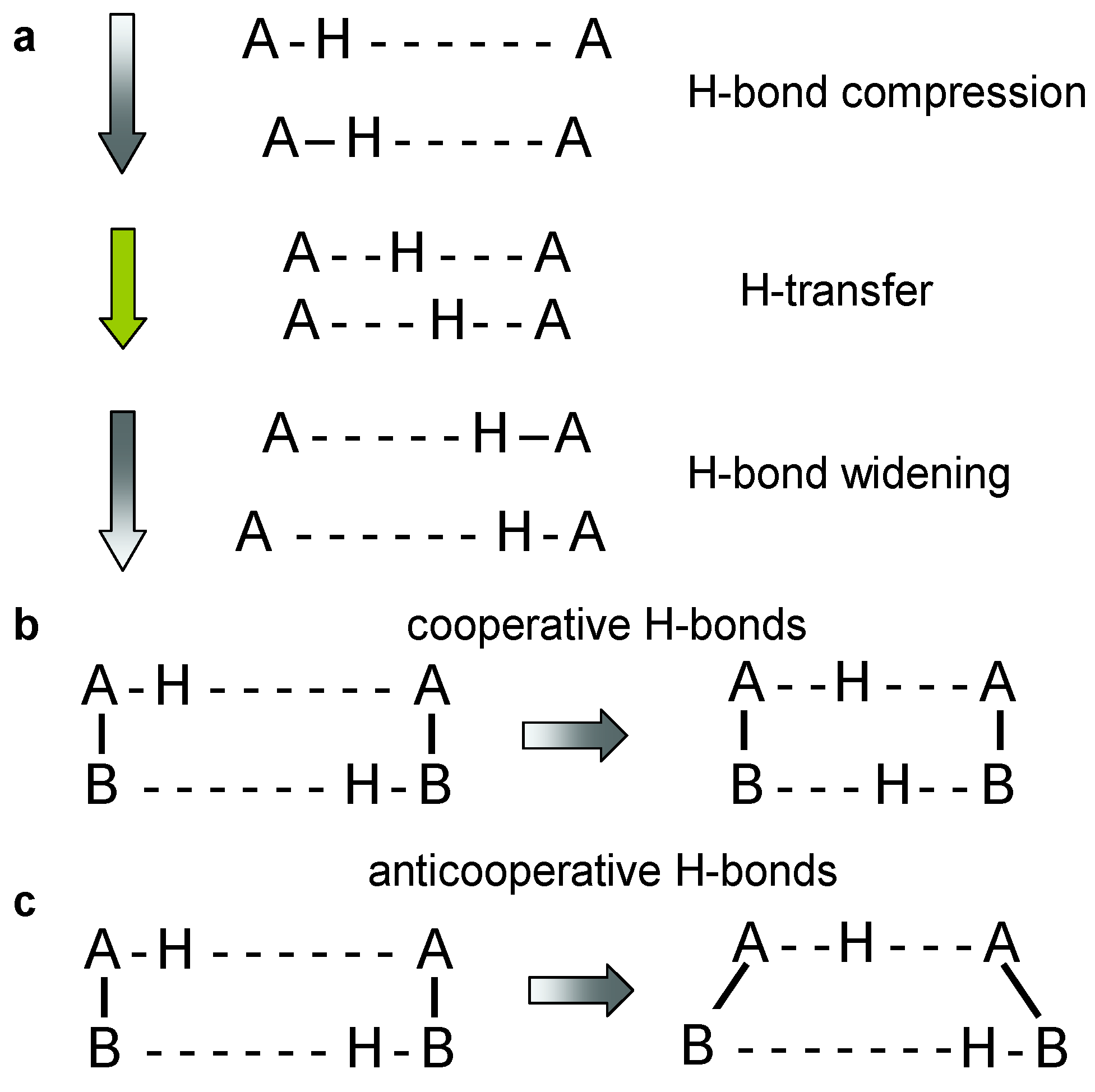
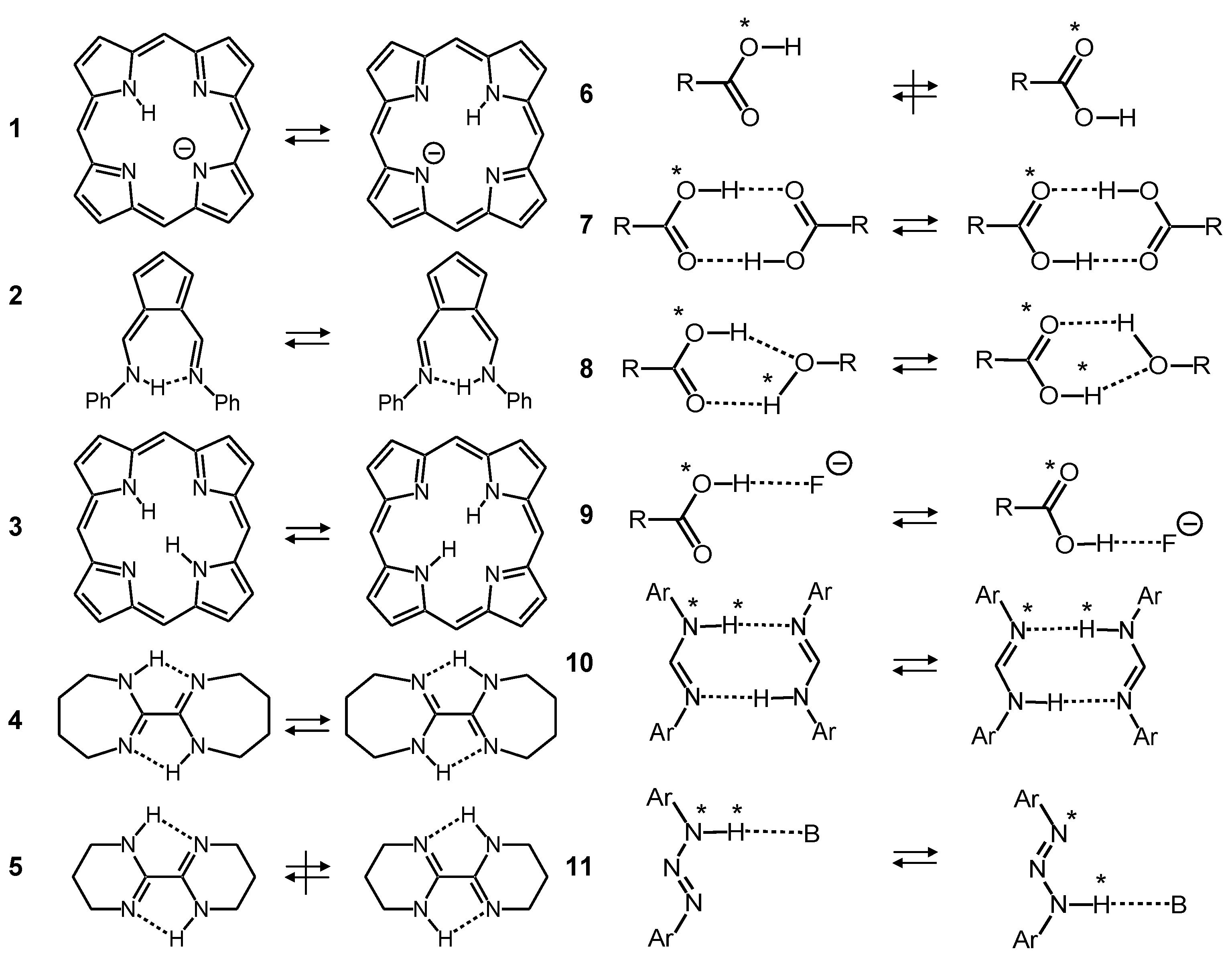


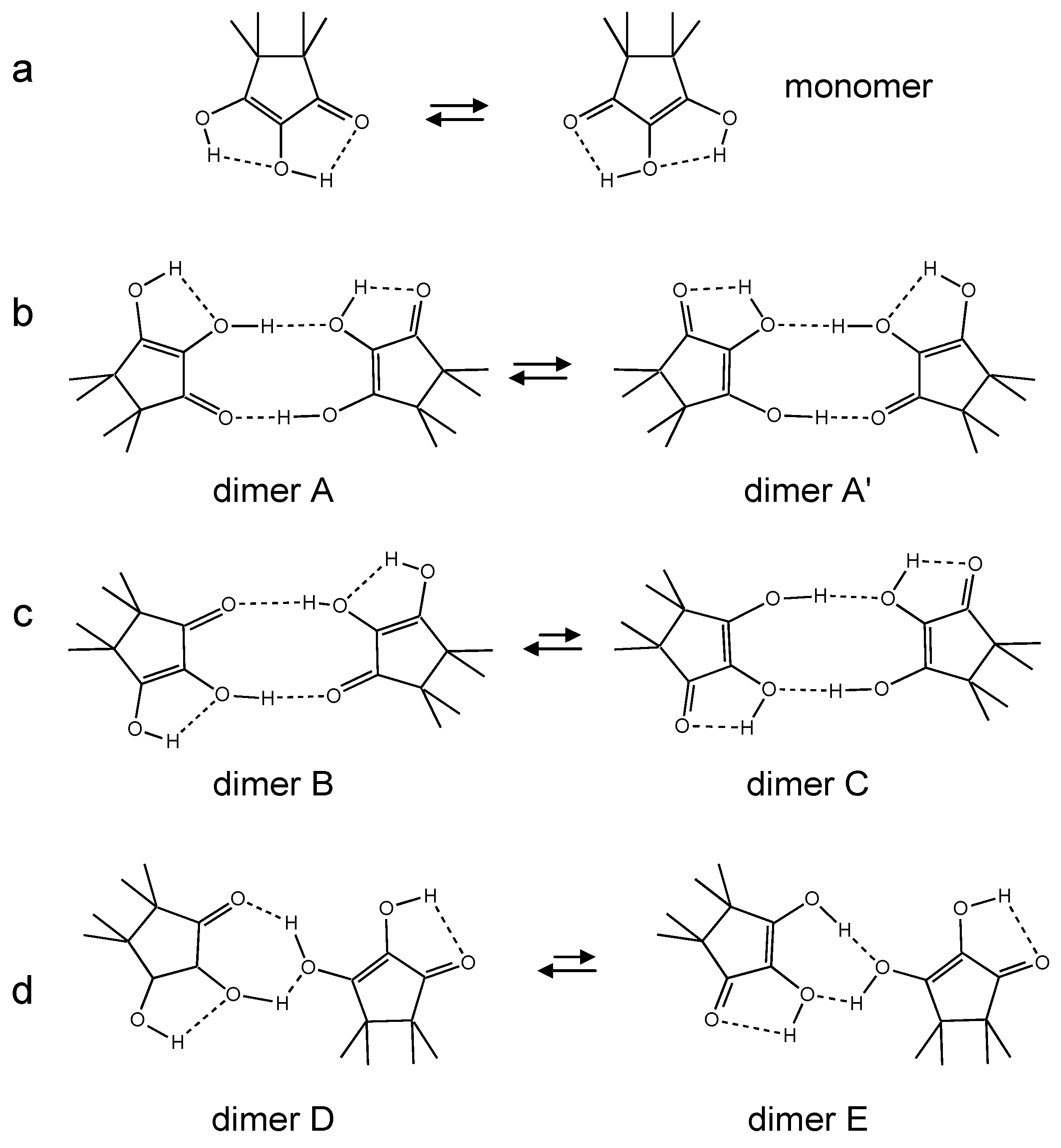
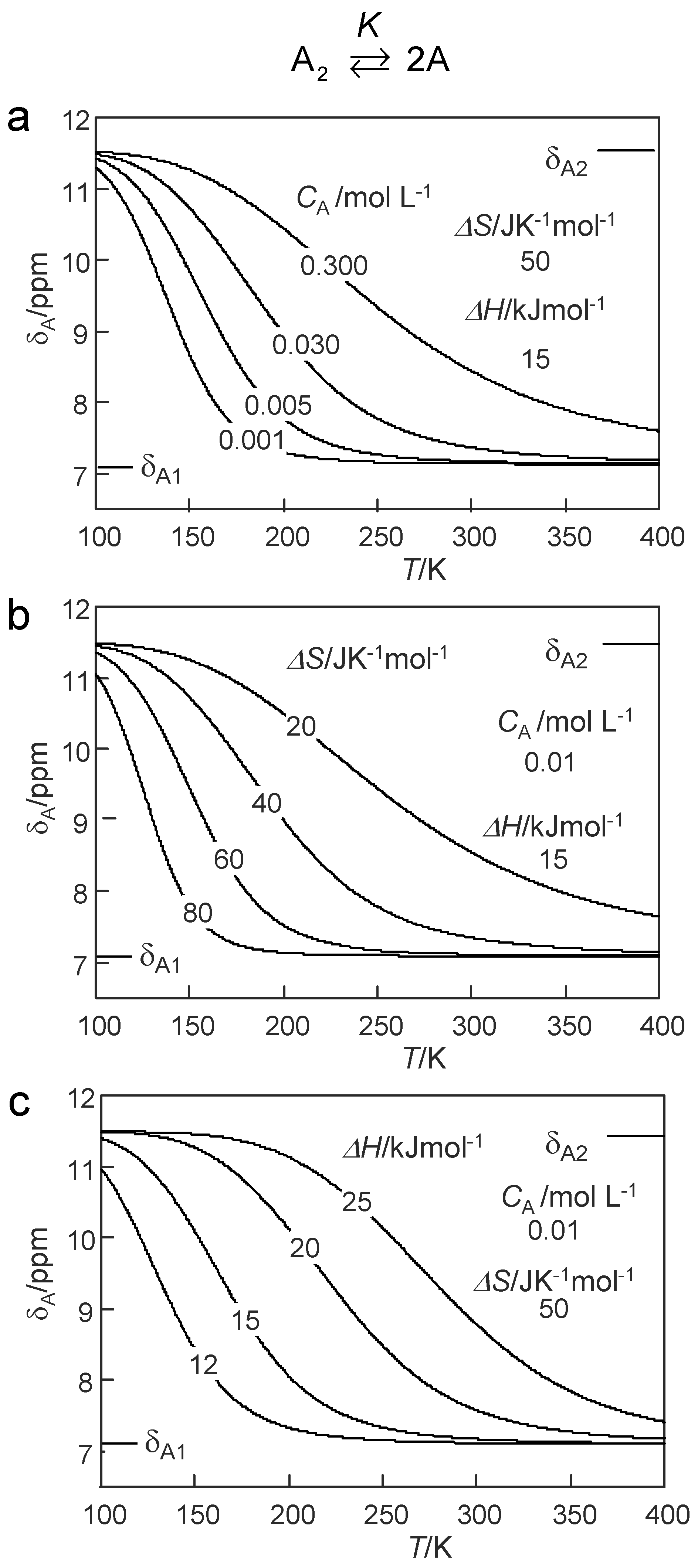


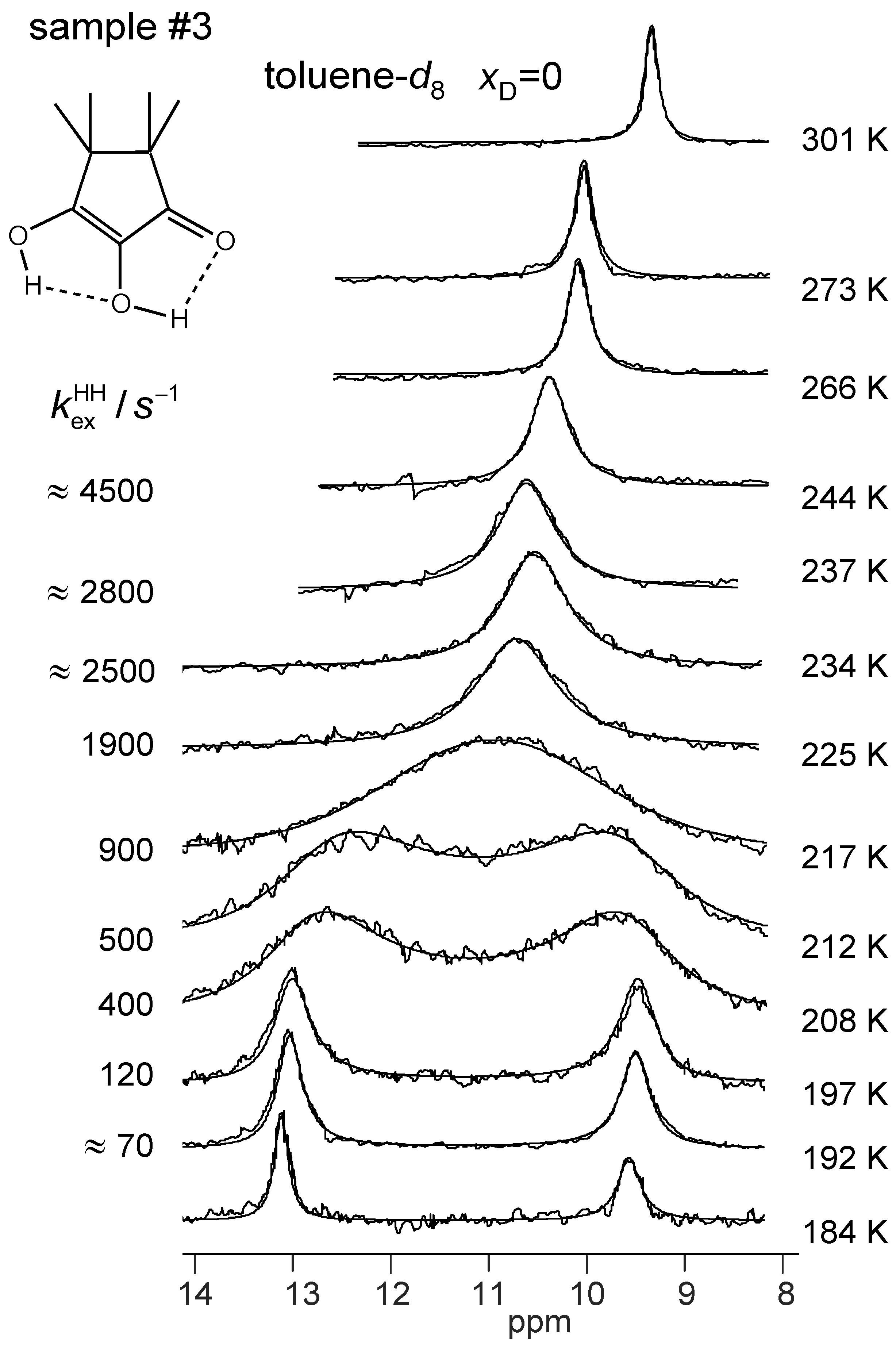

 : Experimental values of samples #2 and #4 used to determine the parameters of the solid line, i.e., the intrinsic chemical shift of the monomer δA1 = 7.1 ppm, of the dimer δA2 = 11.5 ppm and of the equilibrium constant K = 0.024 mol L−1.
: Experimental values of samples #2 and #4 used to determine the parameters of the solid line, i.e., the intrinsic chemical shift of the monomer δA1 = 7.1 ppm, of the dimer δA2 = 11.5 ppm and of the equilibrium constant K = 0.024 mol L−1.  : the chemical shift value of sample #3 was placed on the solid line in order to determine the total concentration CA = 0.024 mol L−1 corresponding to about half of TRMA in the monomer and half in the dimer.
: the chemical shift value of sample #3 was placed on the solid line in order to determine the total concentration CA = 0.024 mol L−1 corresponding to about half of TRMA in the monomer and half in the dimer.
 : Experimental values of samples #2 and #4 used to determine the parameters of the solid line, i.e., the intrinsic chemical shift of the monomer δA1 = 7.1 ppm, of the dimer δA2 = 11.5 ppm and of the equilibrium constant K = 0.024 mol L−1.
: Experimental values of samples #2 and #4 used to determine the parameters of the solid line, i.e., the intrinsic chemical shift of the monomer δA1 = 7.1 ppm, of the dimer δA2 = 11.5 ppm and of the equilibrium constant K = 0.024 mol L−1.  : the chemical shift value of sample #3 was placed on the solid line in order to determine the total concentration CA = 0.024 mol L−1 corresponding to about half of TRMA in the monomer and half in the dimer.
: the chemical shift value of sample #3 was placed on the solid line in order to determine the total concentration CA = 0.024 mol L−1 corresponding to about half of TRMA in the monomer and half in the dimer.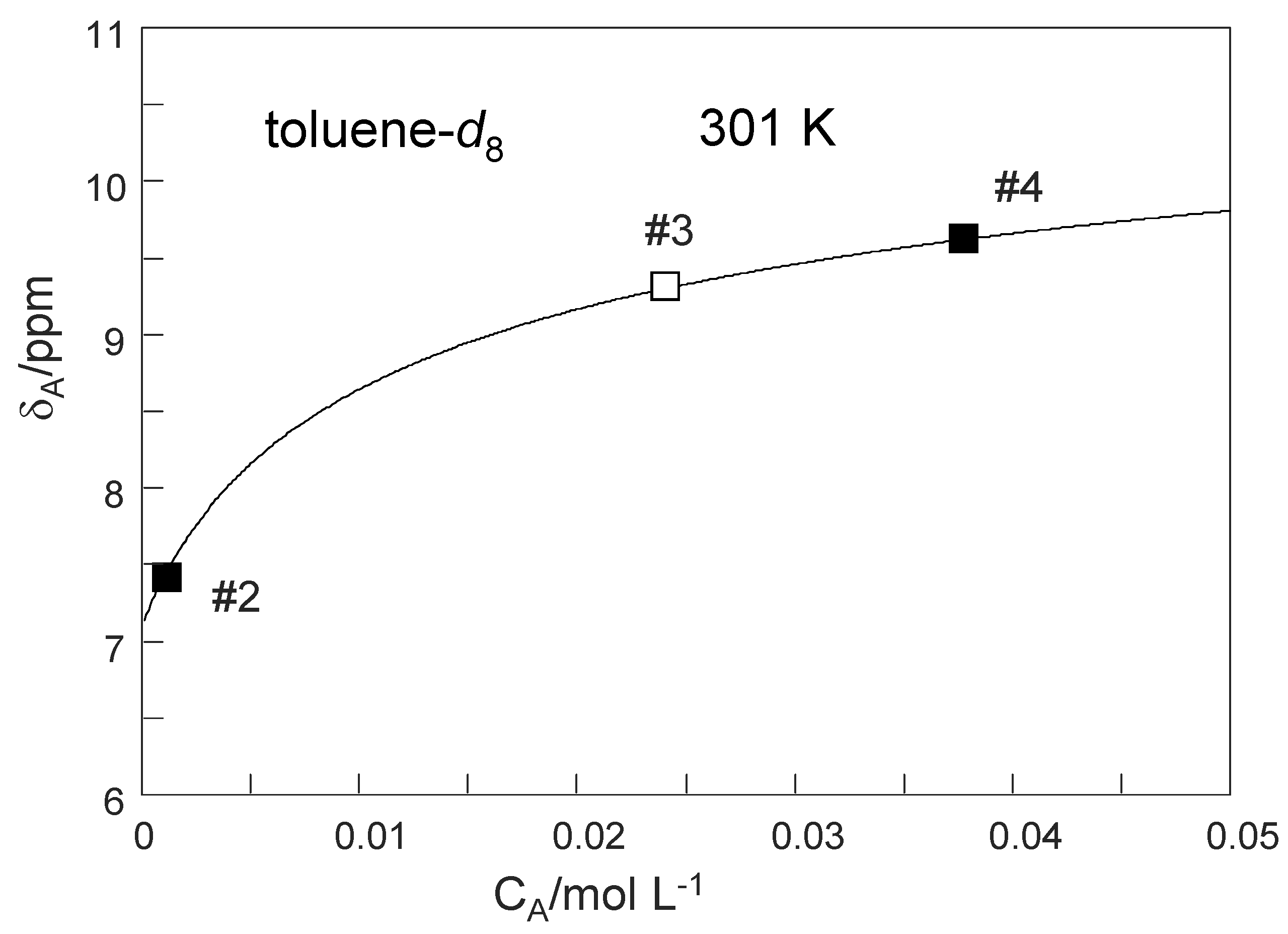
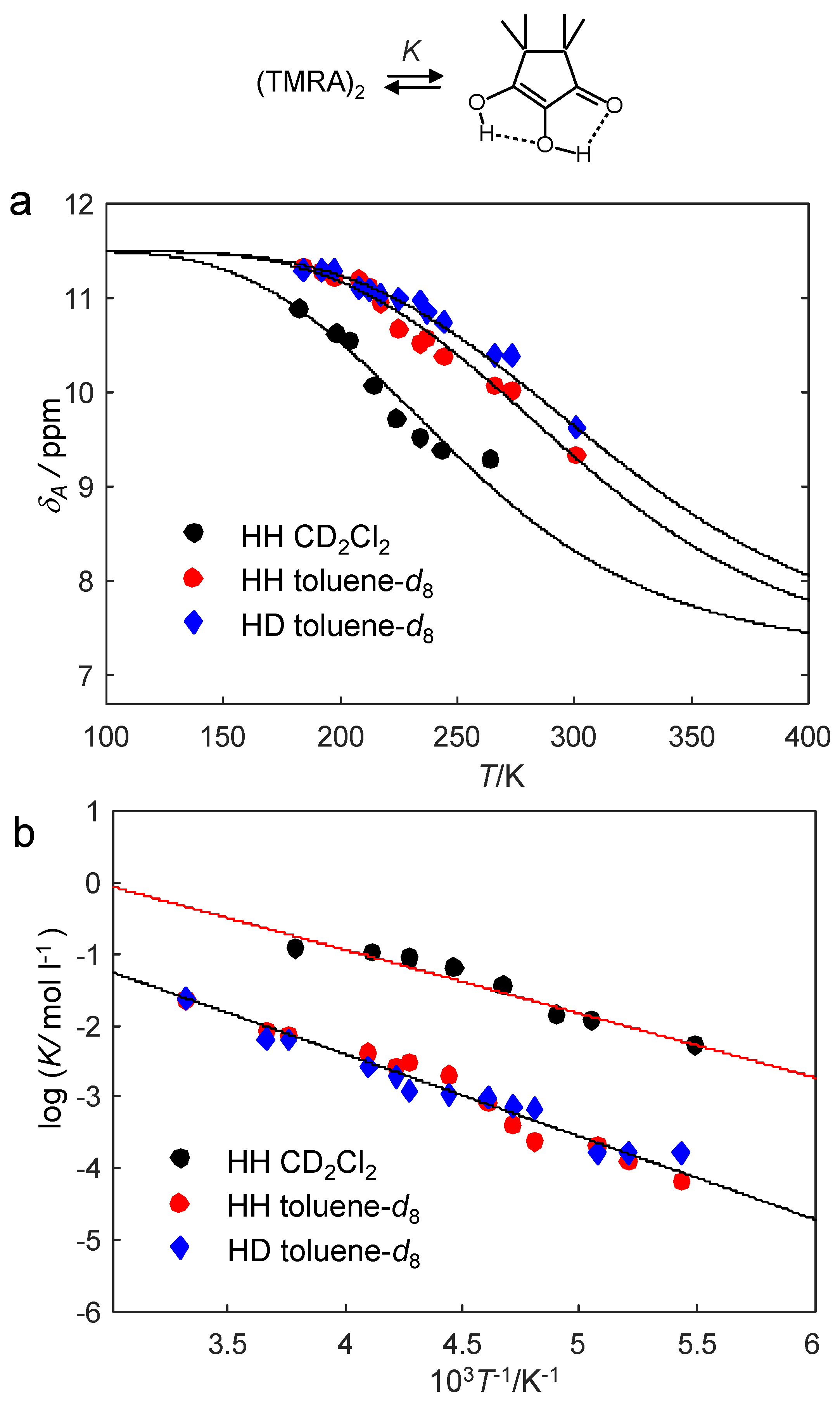
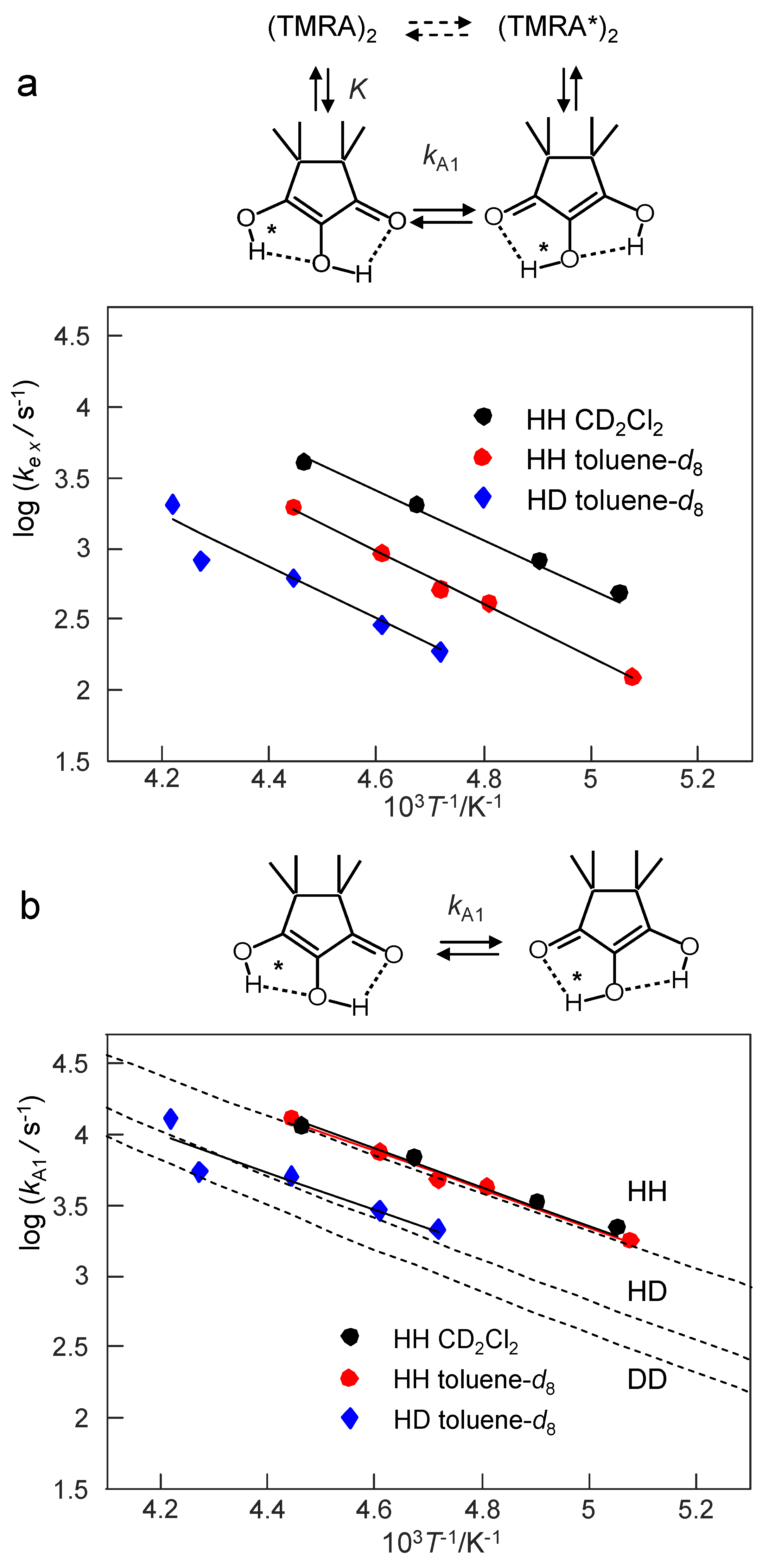
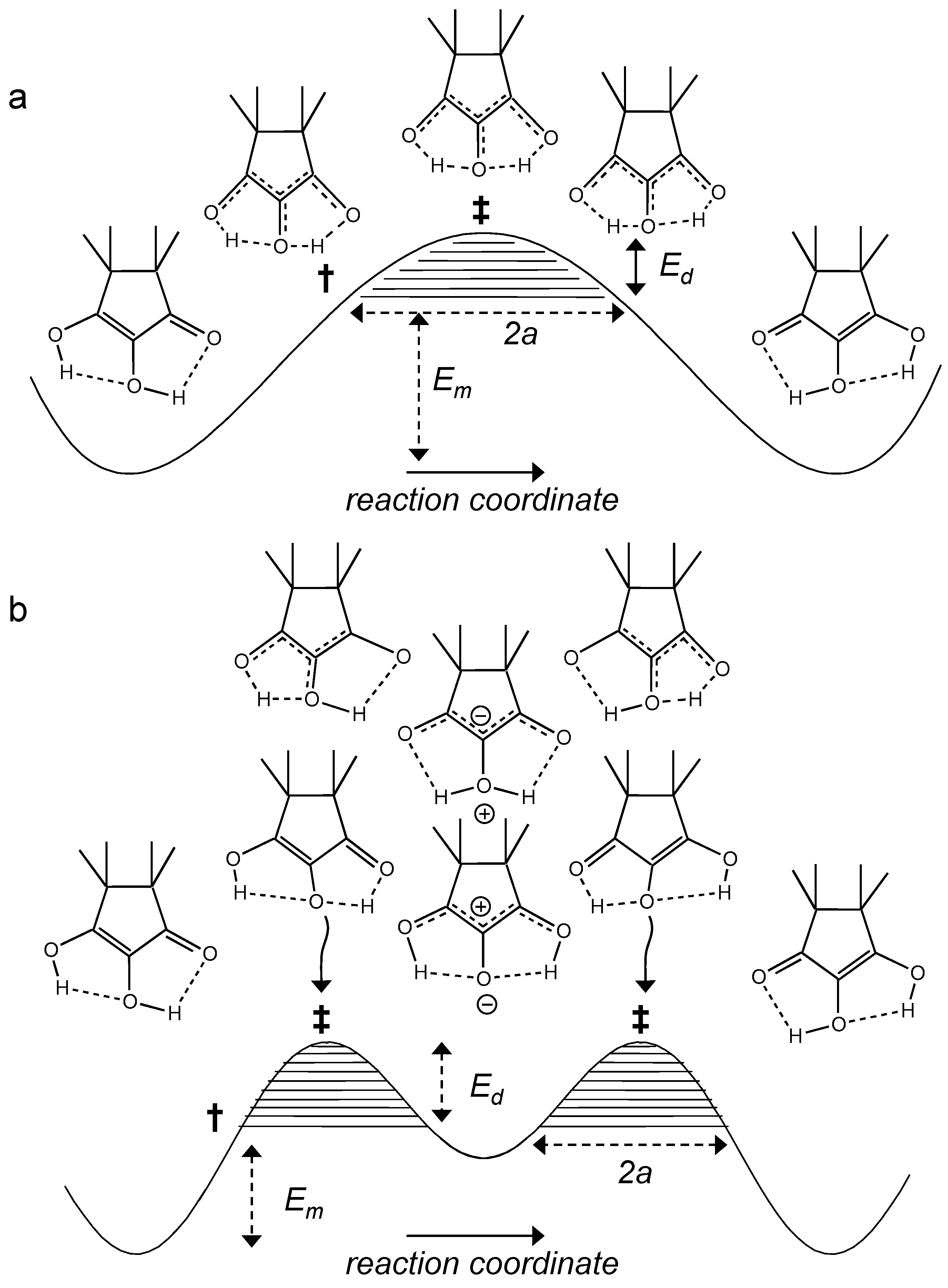
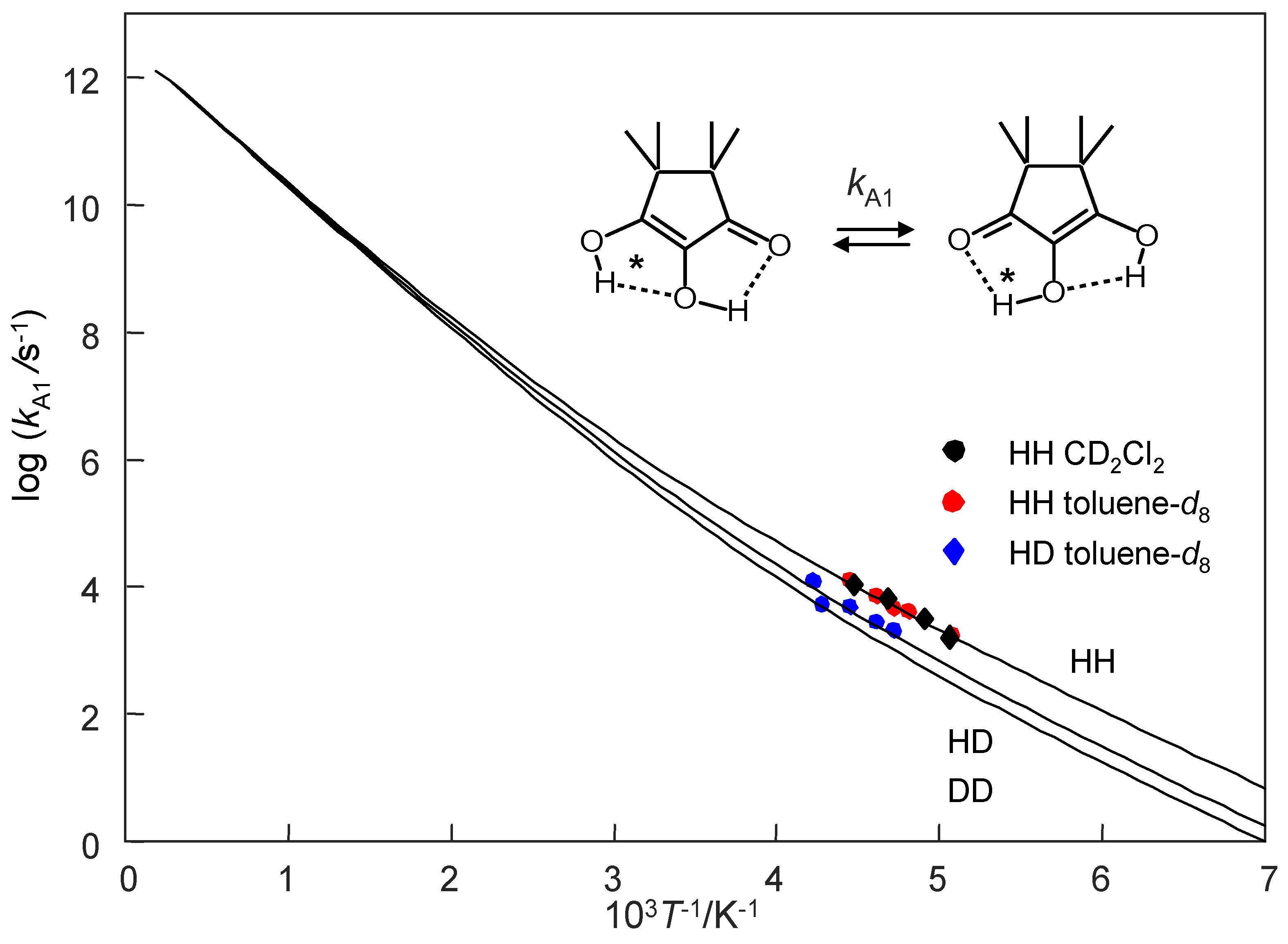
| Sample | Solvent | CA | XD | δOH |
|---|---|---|---|---|
| #1 | CD2Cl2 | 0.12 a | 0 | - |
| #2 | toluene-d8 | 0.00108 a | 0 | 7.4 |
| #3 | toluene-d8 | 0.024 b | 0 | 9.34 |
| #4 | toluene-d8 | 0.038 a | 0.88 c | 9.63 |
| sample #3, solvent toluene-d8, deuterium fraction XD = 0 | ||||||||||
| T/K | ν1 − νTMS | ν2 − νTMS | ν1 − ν2 | ½(ν1 + ν2) | W01 | W02 | K/mol L−1 | xA1 | /s−1 | /s−1 |
| 184 | 1179 (13.1) | 860 (9.55) | 319 | 1021 (11.34) | 15 | 25 | 0.6 × 10−4 | 0.05 | - | - |
| 192 | 1174 (13.04) | 855 (9.49) | 319 | 1014 (11.28) | 5 | 5 | 1.2 × 10−4 | 0.07 | ≈70 | - |
| 197 | 1173 (13.02) | 852 (9.46) | 321 | 1012 (11.22) | 5 | 5 | 2.1 × 10−4 | 0.09 | 120 | 1800 |
| 208 | 1160 (12.89) | 845 (9.39) | 321 | 1003 (11.14) | 5 | 5 | 2.4 × 10−4 | 0.09 | 400 | 4300 |
| 212 | 1159 (12.87) | 841 (9.34) | 318 | 1000 (11.11) | 5 | 5 | 4.1 × 10−4 | 0.12 | 500 | 4800 |
| 217 | 1144 (12.71) | 826 (9.18) | 318 * | 985 (10.95) | 5 | 5 | 8.5 × 10−4 | 0.16 | 900 | 7500 |
| 225 | 1122 (12.46) | 807 (8.96) | 315 * | 964 (10.68) | 5 | 5 | 2.0 × 10−3 | 0.22 | 1900 | 13,000 |
| 234 | 1105 (12.28) | 790 (8.78) | 315 * | 947 (10.52) | 5 | 5 | 3.0 × 10−3 | 0.25 | ≈2500 | - |
| 237 | 1110 (12.33) | 795 (8.83) | 315 * | 952 (10.58) | 5 | 5 | 2.6 × 10−3 | 0.24 | ≈2800 | - |
| 244 | 1092 (12.13) | 777 (6.63) | 315 * | 934 (10.38) | 5 | 5 | 4.1 × 10−3 | 0.28 | ≈4500 | - |
| 266 | 1065 (11.83) | 750 (8.33) | 315 * | 907 (10.08) | 5 | 5 | 7.3 × 10−3 | 0.33 | ≈8000 | - |
| 273 | 1060 (11.78) | 745 (8.28) | 315 * | 902 (10.02) | 5 | 5 | 8.1 × 10−3 | 0.34 | ≈10,000 | - |
| 301 | 998 (11.09) | 683 (7.59) | 315 * | 841 (9.34) | 5 | 5 | 2.3 × 10−2 | 0.41 | ≈15,000 | - |
| sample #4, solvent toluene-d8, deuterium fraction XD = 0.88 | ||||||||||
| T/K | ν1 − νTMS | ν2 − νTMS | ν1 − ν2 | ½(ν1 + ν2) | W01 | W02 | K/mol L−1 | xA1 | /s−1 | /s−1 |
| 184 | 1179 (13.1) | 860 (9.55) | 319 | 1021 (11.34) | 20 | 30 | 1.6 × 10−4 | 0.06 | - | - |
| 192 | 1174 (13.04) | 855 (9.49) | 319 | 1014 (11.28) | 20 | 20 | 1.6 × 10−4 | 0.06 | - | - |
| 197 | 1170 (13.00) | 854 (9.49) | 319 | 1012 (11.24) | 5 | 5 | 1.6 × 10−4 | 0.06 | - | - |
| 208 | 1160 (12.89) | 843 (9.37) | 317 | 1002 (11.13) | 5 | 5 | 6.8 × 10−4 | 0.12 | ≈100 | - |
| 212 | 1156 (12.85) | 840 (9.33) | 317 | 998 (11.09) | 5 | 5 | 7.2 × 10−4 | 0.12 | 180 | 2130 |
| 217 | 1152 (12.8) | 834 (9.26) | 318 | 993 (11.03) | 5 | 5 | 9.6 × 10−4 | 0.14 | 280 | 2900 |
| 225 | 1147 (12.75) | 828 (9.25) | 315 * | 990 (11.0) | 5 | 5 | 1.1 × 10−3 | 0.15 | 600 | 5050 |
| 234 | 1143 (12.73) | 831 (9.23) | 315 * | 988 (10.98) | 5 | 5 | 1.2 × 10−3 | 0.15 | 800 | 5450 |
| 237 | 1138 (12.64) | 823 (9.14) | 315 * | 980 (10.89) | 5 | 5 | 1.9 × 10−3 | 0.18 | 2000 | 12,800 |
| 244 | 1127 (12.53) | 812 (9.03) | 315 * | 970 (10.78) | 5 | 5 | 2.6 × 10−3 | 0.21 | - | - |
| 266 | 938 (10.42) | 37 | 6.3 × 10−3 | 0.28 | - | - | ||||
| 273 | 935 (10.39) | 30 | 6.4 × 10−3 | 0.28 | - | - | ||||
| 301 | 867 (9.63) | 30 | 2.4 × 10−2 | 0.39 | - | - | ||||
| sample #1, solvent CD2Cl2, deuterium fraction XD = 0 | ||||||||||
| T/K | ν1 − νTMS | ν2 − νTMS | ν1 − ν2 | ½(ν1 + ν2) | W01 | W02 | K/mol L−1 | xA1 | /s−1 | /s−1 |
| 182 | 1148(12.75) | 812 (9.03) | 335 | 980 (10.89) | 5 | 5 | 0.005 | 0.18 | 140 | - |
| 198 | 1124 (12.49) | 789 (8.77) | 335 | 957 (10.63) | 5 | 5 | 0.012 | 0.23 | 470 | 2250 |
| 204 | 1118 (12.41) | 783 (8.69) | 335 * | 950 (10.55) | 5 | 5 | 0.014 | 0.25 | 800 | 3350 |
| 214 | 1075 (11.94) | 740 (8.21) | 335 * | 907 (10.08) | 5 | 5 | 0.037 | 0.33 | 2000 | 6800 |
| 224 | 1043 (11.59) | 708 (7.87) | 335 * | 876 (9.73) | 5 | 5 | 0.065 | 0.37 | 4000 | 11,500 |
| 234 | 1024 (1138) | 689 (7.66) | 335 * | 857 (9.52) | 5 | 5 | 0.088 | 0.39 | 5500 | - |
| 243 | 1012 (11.25) | 677 (7.53) | 335 * | 845 (9.39) | 5 | 5 | 0.106 | 0.41 | 7500 | - |
| 264 | 1044 (11.16) | 669 (7.44) | 335 * | 837 (9.30) | 5 | 5 | 0.120 | 0.41 | 8500 | - |
| Solvent | Toluene-d8 | Toluene-d8 | CD2Cl2 |
|---|---|---|---|
| CA concentration of TMRA | 0.024 | 0.038 | 0.12 |
| XD deuteron fraction | 0 | 0.88 | 0 |
| δA1/ppm | 7.1 | 7.1 | 7.1 |
| δA2/ppm | 11.5 | 11.5 | 11.5 |
| LL isotopes transferred | HH | HD | HH |
| Eaex/kJ mol−1 | 36.0 | 35.4 | 34.0 |
| log (/s−1) | 11.6 | 11.0 | 11.5 |
| at 217 K | 3.2 | - | |
| ΔH/kJ mol−1 (dimer ⇒ monomer) | 22 | 17 | |
| ΔS/J mol−1K−1 (dimer ⇒ monomer) | 42 | 50 | |
| /kJ mol−1 (of monomer) | 25.6 | 25.1 | 26.7 |
| log (/s−1) (of monomer) | 10.0 | 9.5 | 10.3 |
| δ/ppm | ½(r1 − r2)/Å | r1 + r2 /Å | r1/Å | r2/Å | rO…O/Å | ||
|---|---|---|---|---|---|---|---|
| dimer | O-H···O=C | 13.1 a | 0.34 b | 2.64 b | 0.98 b | 1.66 b | 2.63 |
| dimer | OH···OH | 9.55 a | 0.36 b | 2.68 b | 0.98 b | 1.70 b |
| Solvent | Toluene-d8 | Toluene-d8 | CD2Cl2 |
|---|---|---|---|
| HH | HD | HH | |
| Em/kJmol−1 | 21.8 | 22.6 | 21.8 |
| Ed/kJmol−1 | 22.6 | 20.1 | 22.6 |
| log (A/s−1) | 12.6 | 12.6 | 12.6 |
| mH/a.m.u. | 1 | 1 | 1 |
| mD/a.m.u. | 2 | 2 | 2 |
| Δm/a.m.u. | 1.5 | 1.5 | 1.5 |
| 2a/Å | 0.18 | 0.18 | 0.18 |
| Δε/kJmol−1 | 0.8 | - | |
Publisher’s Note: MDPI stays neutral with regard to jurisdictional claims in published maps and institutional affiliations. |
© 2021 by the authors. Licensee MDPI, Basel, Switzerland. This article is an open access article distributed under the terms and conditions of the Creative Commons Attribution (CC BY) license (https://creativecommons.org/licenses/by/4.0/).
Share and Cite
Limbach, H.-H.; Baumgärtner, S.; Franke, R.; Männle, F.; Scherer, G.; Denisov, G.S. Double Proton Tautomerism via Intra- or Intermolecular Pathways? The Case of Tetramethyl Reductic Acid Studied by Dynamic NMR: Hydrogen Bond Association, Solvent and Kinetic H/D Isotope Effects. Molecules 2021, 26, 4373. https://doi.org/10.3390/molecules26144373
Limbach H-H, Baumgärtner S, Franke R, Männle F, Scherer G, Denisov GS. Double Proton Tautomerism via Intra- or Intermolecular Pathways? The Case of Tetramethyl Reductic Acid Studied by Dynamic NMR: Hydrogen Bond Association, Solvent and Kinetic H/D Isotope Effects. Molecules. 2021; 26(14):4373. https://doi.org/10.3390/molecules26144373
Chicago/Turabian StyleLimbach, Hans-Heinrich, Simone Baumgärtner, Roland Franke, Ferdinand Männle, Gerd Scherer, and Gleb S. Denisov. 2021. "Double Proton Tautomerism via Intra- or Intermolecular Pathways? The Case of Tetramethyl Reductic Acid Studied by Dynamic NMR: Hydrogen Bond Association, Solvent and Kinetic H/D Isotope Effects" Molecules 26, no. 14: 4373. https://doi.org/10.3390/molecules26144373
APA StyleLimbach, H.-H., Baumgärtner, S., Franke, R., Männle, F., Scherer, G., & Denisov, G. S. (2021). Double Proton Tautomerism via Intra- or Intermolecular Pathways? The Case of Tetramethyl Reductic Acid Studied by Dynamic NMR: Hydrogen Bond Association, Solvent and Kinetic H/D Isotope Effects. Molecules, 26(14), 4373. https://doi.org/10.3390/molecules26144373





